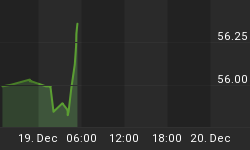Rudy Havenstein Tweeted an interesting chart earlier today on real negative interest rates.
I recreated the chart below and also share a chart from Doug Short on real median incomes to help put this financial repression by the Fed in proper perspective.
Decade of Negative Real Interest Rates

The above chart was created by taking the short-term treasury bill rate and subtracting the year-over-year rate of inflation as measured by the CPI.
A massive housing bubble formed in the first period real interest rates were negative. In the current prolonged period of negative rates, bubbles formed in the stock market and bond markets globally.
Outside the US, nearly three quarters of the world’s bond traded at negative interest rates.
Doug Short at Advisor Perspectives updated his series of charts on Median Household Income earlier today.
Median Household Income, Nominal and Real

Median Household Income Growth

Doug Short notes: The reality illustrated here is that the real median household income series spent most of the first nine years of the 21st century struggling slightly below its purchasing power at the turn of the century. Real incomes (the blue line) hit an interim peak at a fractional 0.7% in early 2008, far below the nominal illusionary interim peak (as in money illusion) of 27.2% six months later and the latest at 42%, a record high. The real median household income is now at -0.6% from its turn-of-the-century level. In essence, the real recovery from the trough has been frustratingly slow."
Who Benefited?
-
Bailed out banks
-
Government bodies via property tax hikes, income tax hikes, sales tax hikes and collection
-
Asset holders – The wealthy
The median guy lost. Those at the bottom end got clobbered much harder. Only the top 10% or so fared well.
The primary beneficiary of QE, negative real rates, and inflation was the top 1%.
The Election
Writers still struggle to explain the election of Trump. The above charts explain clearly.
The median guy on the street is fed up by financial repression. Thanks to mainstream media, the "deplorables" are upset at corporations, at globalization, and at the failure of government to hike minimum wages.
Placing Blame Where It Belongs
Thanks to mainsteam media, which parrots the idea that inflation is good, the "deplorables" fail to blame the institution most responsible: the Fed.
Globalization is a good thing. Falling prices are a good thing.
The average guy on the street understands the latter, but not the former. The average economist, brainwashed by years of Keynesian economic training fails to understand anything.
Academia and mainstream media parrot patently false theories on the benefits of inflation and tariffs. Instead of picketing the Fed, the "deplorables" voted for Trump.
Economist Paul Krugman need only look in a mirror to see one of the reasons the "deplorables" voted the way they day. Krugman still fails to understand what happened.
Shortly after the election, Krugman made a confession: Krugman Admits He Is Clueless. That Progress will be Short-Lived

Explaining Trump
Here is a the key chart from Explaining Social Anger, Brexit, Donald Trump in One Chart.
Shrinking Middle Class

The above chart from the Wall Street Journal article IMF’s Grim Long-Term U.S. Outlook in Six Charts.

Economic Challenge to Keynesians
Of all the widely believed but patently false economic beliefs is the absurd notion that falling consumer prices are bad for the economy and something must be done about them.
I have commented on this many times and have been vindicated not only by sound economic theory but also by actual historical examples.
For a synopsis, please see Deflation Bonanza! (And the Fool’s Mission to Stop It).
My Challenge to Keynesians "Prove Rising Prices Provide an Overall Economic Benefit" has gone unanswered.
There is no answer because history and logic both show that concerns over consumer price deflation are seriously misplaced.
The Fed’s fight against deflation is amazingly counterproductive and the above charts provide ample evidence.
Routine Deflation Harmless
Routine CPI deflation is harmless. The Bank of International Settlements (BIS), did a detailed study and agrees. For details, please see Historical Perspective on CPI Deflations: How Damaging are They?
In their attempts to fight routine consumer price deflation, central bankers create extremely destructive asset bubbles that eventually collapse, setting off what they should fear – asset bubble deflation.

The final irony in this sad saga is Paul Krugman, Who Proposed Fight with Fake Outer Space Aliens to Stimulate the Economy, Now Worried About Quality of Trump’s Spending.
















